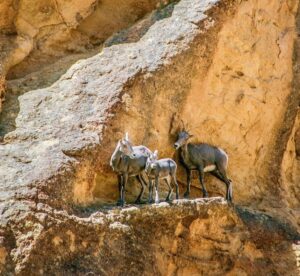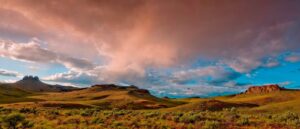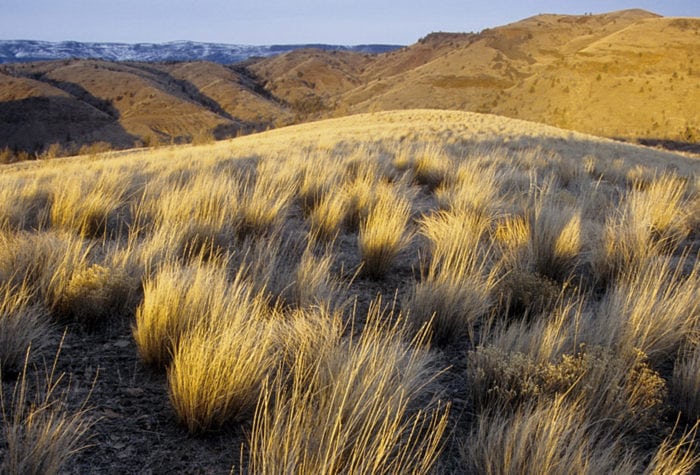Author: Karly Foster | Published: December 28, 2023 | Category: How-To
This article originally appeared in The Source on December 13, 2023.
Reflect on a year of enjoying the wonders of our natural world. Resolve to be a protector in 2024.

Revel in the magic of the desert.
If you live, work or play amongst the wonderland that is Oregon’s high desert, you understand how truly magical this place is. Amid the blanket of sagebrush stretching to the horizon lies an unseen, diverse world, moving at a pace and scale that transcends human timelines and earthly space. Above, spires tower and mountains soar. Raptors of ancient lineage rule the skies where emotive and unforgettable sunsets stretch on for what feels like forever. If you’ve experienced this epic scene, you might have also fallen in love with it, and maybe even been moved to protect it.
Be curious, explore and learn.
Conservation advocacy comes from the heart and by being in relationship with the wildlife, wildlands and waters of interest. Being open to exploring and learning all that a place has to teach us is a great way to begin your desert educational journey and grow that relationship. Visiting Oregon Natural Desert Association’s blog is a good first step you can take from the comfort of your home: discover visitor’s guides on various landscapes, read where to find desert wildflowers or spot raptors, learn how to photograph the desert, and dive into spotlights on species such as the unbelievably adorable pygmy rabbit. Of course, the best way to truly know a place is by experiencing it yourself – so go immerse yourself in the high desert and take in with all your senses the enchantment of this unique place.
Face the truth.
Once you’ve opened your mind and heart to the nearly one-third of Oregon characterized by the sagebrush steppe ecosystem, it’s time to dive deep. Oregon is often stereotyped as being an environment-loving state, home to tens of millions of acres of public lands to be adored and explored, yet Oregon ranks near last for conserving public lands compared to other western states, coming in ninth place behind other states like Idaho, Montana and Nevada.
The lack of protections for public lands in our vast state is cause for alarm for the wildlands, watersheds and habitats that hundreds of species, many only found in these ecosystems, call home. Unfortunately, the threats to the high desert are very real. From an upsurge in mining claims and other industrial development, to landscape-scale pressures from climate change such as wildfires, invasive species and water loss, this landscape needs our voice.
So, what can you do?

Take Action
There are many ways to get involved in protecting Oregon’s vast and diverse high desert. One campaign in particular is considered the greatest conservation opportunity in the American West. The Owyhee Canyonlands, often referred to as “Oregon’s Grand Canyon,” is a huge, but little-known treasure in the southeastern corner of the state. The Protect the Owyhee Campaign, supported by a broad coalition of organizations, communities, businesses and elected leaders is calling on President Biden to designate an Owyhee Canyonlands National Monument. Long protected by its remoteness, the Owyhee now faces the same looming threats as the rest of Oregon’s high desert.
Get involved in this campaign by joining the growing chorus of voices supporting permanent protection for the Owyhee. You can start by signing the petition for the Owyhee’s future. If you already have a deep connection with the Owyhee and want to level up your advocacy, consider writing to your local newspaper (hey, how about this one!) about why the Owyhee deserves special designation. Or, you can achieve all-star-level advocate status by writing a letter of support for the national monument and sending it to Karly Foster. Every signature, letter or share, matters.
Resolve to be a protector.
If you’re not already considering becoming an advocate for Oregon’s high desert as your New Year’s resolution, why not? Go explore, vow to get involved and stay informed by signing up for Oregon Natural Desert Association’s e-newsletter. You will become part of an impassioned, committed community of desert lovers and advocates. Our high desert wildlife, lands, and waters will thank you, and you’ll feel great knowing you’ve contributed to one of the greatest public lands conservation legacies in the nation.
Good on you!
− Karly Foster is the campaign manager with Oregon Natural Desert Association, a nonprofit organization that protects, restores and defends Oregon’s high desert public lands and waters.
